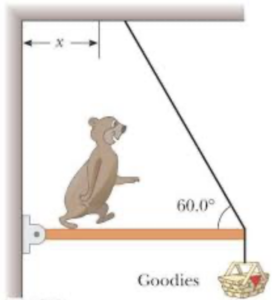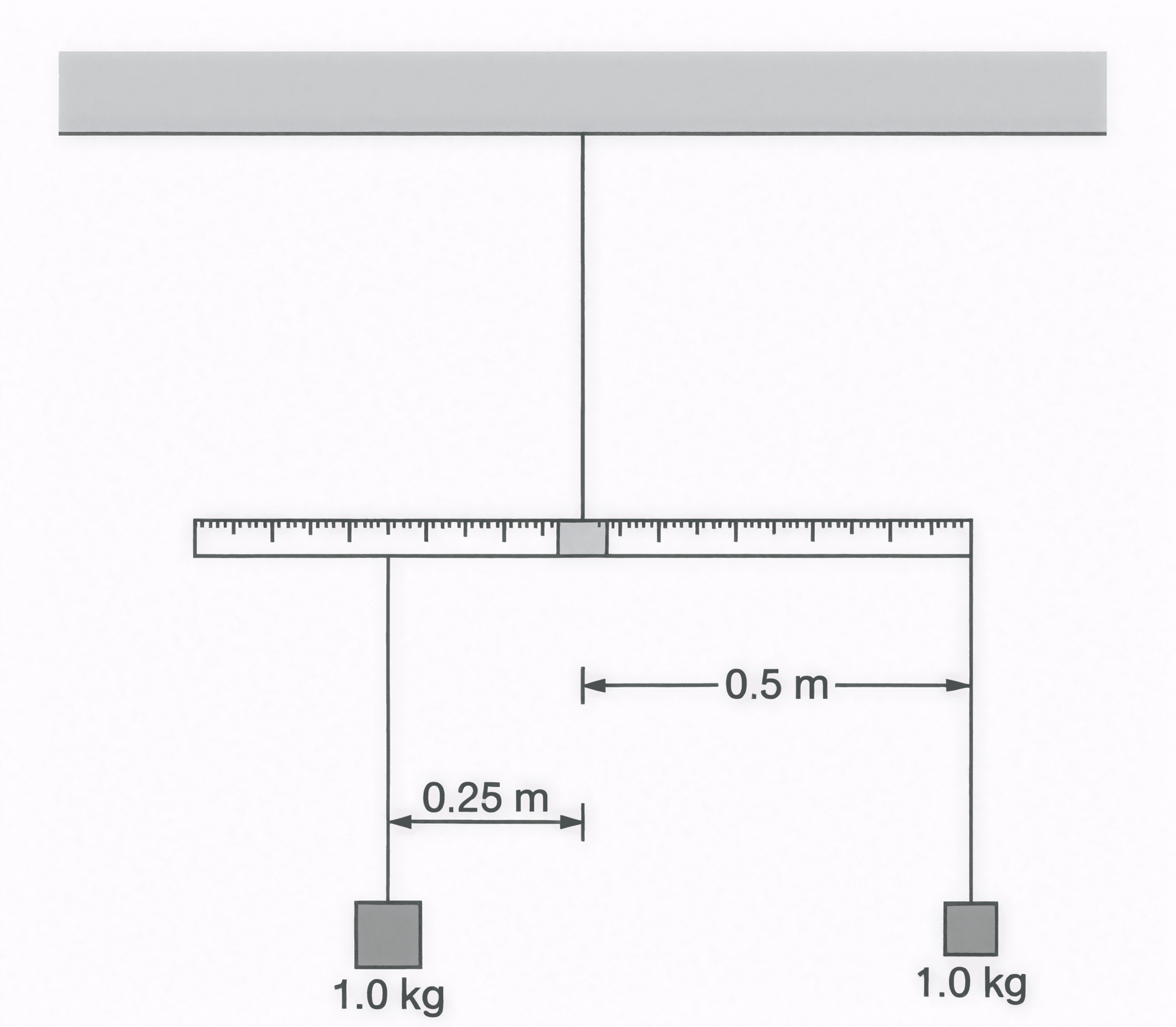0 attempts
0% avg
UBQ Credits
| Step | Derivation/Formula | Reasoning |
|---|---|---|
| 1 | \[ U_i = m_z g (2.5) + m_y g (0) \] | Initial gravitational potential energy is only from \(m_z\) at a height of 2.5 m since \(m_y\) is on the ground. |
| 2 | \[ U_f = m_z g (0) + m_y g (2.5) \] | Final gravitational potential energy has \(m_y\) raised 2.5 m while \(m_z\) reaches the ground. |
| 3 | \[ \Delta U = U_f – U_i = (m_y – m_z)g (2.5) \] | The change in potential energy is the difference between the final and initial energies. Since \(m_y < m_z\) the result is negative, indicating energy conversion to kinetic energy. |
| 4 | \[ KE_{\text{total}} = \frac{1}{2}(m_z+m_y)v^2 + \frac{1}{2}I\omega^2 \] | The total kinetic energy is the sum of the translational kinetic energies of both masses and the rotational kinetic energy of the pulley. |
| 5 | \[ I = \frac{1}{2}MR^2 \quad \text{and} \quad \omega = \frac{v}{R} \] | For a uniform cylinder, the moment of inertia is \(\frac{1}{2}MR^2\), and the no-slip condition gives \(\omega = v/R\). |
| 6 | \[ KE_{\text{pulley}} = \frac{1}{2}\left(\frac{1}{2}MR^2\right)\left(\frac{v}{R}\right)^2 = \frac{1}{4}Mv^2 \] | This expresses the pulley’s rotational kinetic energy in terms of \(v\). |
| 7 | \[ (m_z-m_y)g(2.5) = \frac{1}{2}(m_z+m_y)v^2 + \frac{1}{4}Mv^2 \] | Conservation of energy requires the loss in gravitational potential energy to equal the gain in kinetic energy. |
| 8 | \[ v^2 = \frac{(m_z-m_y)g(2.5)}{\frac{1}{2}(m_z+m_y) + \frac{1}{4}M} \] | Algebraically solving for \(v^2\) isolates the speed in terms of the given masses, gravity, and pulley mass. |
| 9 | \[ v = \sqrt{\frac{(38-32)(9.8)(2.5)}{\frac{1}{2}(32+38) + \frac{1}{4}(3.1)}} \] | Substitute \(m_z=38\) kg, \(m_y=32\) kg, and \(M=3.1\) kg. The numerator is \(6\cdot9.8\cdot2.5=147\) and the denominator is \(35+0.775=35.775\). |
| 10 | \[ v \approx \sqrt{\frac{147}{35.775}} \approx \sqrt{4.107} \approx 2.03 \text{ m/s} \] | Taking the square root gives the speed of \(m_z\) just before impact. |
| 11 | \[ \boxed{v = 2.03 \text{ m/s}} \] | This is the final answer using energy conservation. |
| Step | Derivation/Formula | Reasoning |
|---|---|---|
| 1 | \[ m_zg – T_z = m_za \] | For the falling mass \(m_z\), the net force is its weight minus the tension \(T_z\). |
| 2 | \[ T_y – m_yg = m_ya \] | For the rising mass \(m_y\), the net force is the tension \(T_y\) minus its weight. |
| 3 | \[ (T_z – T_y)R = I\alpha \] | The difference in tension produces a net torque on the pulley. With \(\alpha = \frac{a}{R}\) (no slip), this relates linear acceleration to angular acceleration. |
| 4 | \[ I = \frac{1}{2}MR^2 \quad \text{and} \quad \alpha = \frac{a}{R} \] | Substitute the moment of inertia for a uniform cylinder and express \(\alpha\) in terms of \(a\). |
| 5 | \[ T_z – T_y = \frac{1}{2}Ma \] | Simplify the torque equation using the expression for \(I\): \((T_z-T_y)R = \frac{1}{2}MR^2\cdot\frac{a}{R}\) leads to this equation. |
| 6 | \[ T_z = m_zg – m_za \quad \text{and} \quad T_y = m_yg + m_ya \] | Express tensions from the force equations for each mass. |
| 7 | \[ (m_z-g – m_z\,a) – (m_yg + m_ya) = (m_z-m_y)g – (m_z+m_y)a = \frac{1}{2}Ma \] | Subtracting the two tension expressions gives a relation between \(a\) and the masses. |
| 8 | \[ a = \frac{(m_z-m_y)g}{(m_z+m_y)+\frac{1}{2}M} \] | Rearrange the equation to solve for the linear acceleration \(a\). |
| 9 | \[ a = \frac{(38-32)\,9.8}{(38+32)+\frac{1}{2}(3.1)} = \frac{6\cdot9.8}{70+1.55} \] | Substitute \(m_z=38\) kg, \(m_y=32\) kg, and \(M=3.1\) kg. The denominator becomes \(70+1.55=71.55\) and the numerator is \(58.8\). |
| 10 | \[ a \approx \frac{58.8}{71.55} \approx 0.821 \text{ m/s}^2 \] | This yields the acceleration of the masses. |
| 11 | \[ v^2 = 2a\Delta x \quad \text{with} \quad \Delta x = 2.5 \text{ m} \] | Use the kinematic equation for constant acceleration, where \(\Delta x\) is the distance \(m_z\) falls. |
| 12 | \[ v = \sqrt{2(0.821)(2.5)} \approx \sqrt{4.105} \approx 2.03 \text{ m/s} \] | Taking the square root gives the final speed of \(m_z\), which verifies the answer from part (a). |
| 13 | \[ \boxed{v = 2.03 \text{ m/s}} \] | This confirms the speed obtained using the forces, torque, and kinematics method. |
Just ask: "Help me solve this problem."
You try to open a door, but you are unable to push at a right angle to the door. So, you push the door at an angle of \( 35^{\circ} \) from the horizontal. How much harder would you have to push to open the door just as fast as if you were to push it at \( 90^{\circ} \)?
A 150-kg merry-go-round in the shape of a uniform, solid, horizontal disk of radius 1.50 m is set in motion by wrapping a rope about the rim of the disk and pulling on the rope.
What constant force must be exerted on the rope to bring the merry-go-round from rest to an angular speed of 0.500 rev/s in 2.00 s?
Note: [katex] I_\text{disk} = \frac{1}{2}mr^2 [/katex]
A rod of length \( L \) is rotated about its center with \( I = \frac{ML^{2}}{12} \). What is the moment of inertia at a point \( \frac{L}{4} \) away from the center?

A hungry bear weighing 700 N walks out on a beam in an attempt to retrieve a basket of goodies hanging at the end of the beam. The beam is uniform, weighs 200 N, and is 6.00 m long. The goodies weigh 80 N.

A meterstick is supported at its center, which is aligned with the center of a cradle located at position \( x = 0 \) \( \text{m} \). Two identical objects of mass \( 1.0 \) \( \text{kg} \) are suspended from the meterstick. One object hangs \( 0.25 \) \( \text{m} \) to the left of the support point, and the other object hangs \( 0.50 \) \( \text{m} \) to the right of the support point. The system is released from rest and is free to rotate. Which of the following claims correctly describes the subsequent motion of the system containing the meterstick, cradle, and the two objects?
\(2.03 \text{ m/s}\)
By continuing you (1) agree to our Terms of Use and Terms of Sale and (2) consent to sharing your IP and browser information used by this site’s security protocols as outlined in our Privacy Policy.
| Kinematics | Forces |
|---|---|
| \(\Delta x = v_i t + \frac{1}{2} at^2\) | \(F = ma\) |
| \(v = v_i + at\) | \(F_g = \frac{G m_1 m_2}{r^2}\) |
| \(v^2 = v_i^2 + 2a \Delta x\) | \(f = \mu N\) |
| \(\Delta x = \frac{v_i + v}{2} t\) | \(F_s =-kx\) |
| \(v^2 = v_f^2 \,-\, 2a \Delta x\) |
| Circular Motion | Energy |
|---|---|
| \(F_c = \frac{mv^2}{r}\) | \(KE = \frac{1}{2} mv^2\) |
| \(a_c = \frac{v^2}{r}\) | \(PE = mgh\) |
| \(T = 2\pi \sqrt{\frac{r}{g}}\) | \(KE_i + PE_i = KE_f + PE_f\) |
| \(W = Fd \cos\theta\) |
| Momentum | Torque and Rotations |
|---|---|
| \(p = mv\) | \(\tau = r \cdot F \cdot \sin(\theta)\) |
| \(J = \Delta p\) | \(I = \sum mr^2\) |
| \(p_i = p_f\) | \(L = I \cdot \omega\) |
| Simple Harmonic Motion | Fluids |
|---|---|
| \(F = -kx\) | \(P = \frac{F}{A}\) |
| \(T = 2\pi \sqrt{\frac{l}{g}}\) | \(P_{\text{total}} = P_{\text{atm}} + \rho gh\) |
| \(T = 2\pi \sqrt{\frac{m}{k}}\) | \(Q = Av\) |
| \(x(t) = A \cos(\omega t + \phi)\) | \(F_b = \rho V g\) |
| \(a = -\omega^2 x\) | \(A_1v_1 = A_2v_2\) |
| Constant | Description |
|---|---|
| [katex]g[/katex] | Acceleration due to gravity, typically [katex]9.8 , \text{m/s}^2[/katex] on Earth’s surface |
| [katex]G[/katex] | Universal Gravitational Constant, [katex]6.674 \times 10^{-11} , \text{N} \cdot \text{m}^2/\text{kg}^2[/katex] |
| [katex]\mu_k[/katex] and [katex]\mu_s[/katex] | Coefficients of kinetic ([katex]\mu_k[/katex]) and static ([katex]\mu_s[/katex]) friction, dimensionless. Static friction ([katex]\mu_s[/katex]) is usually greater than kinetic friction ([katex]\mu_k[/katex]) as it resists the start of motion. |
| [katex]k[/katex] | Spring constant, in [katex]\text{N/m}[/katex] |
| [katex] M_E = 5.972 \times 10^{24} , \text{kg} [/katex] | Mass of the Earth |
| [katex] M_M = 7.348 \times 10^{22} , \text{kg} [/katex] | Mass of the Moon |
| [katex] M_M = 1.989 \times 10^{30} , \text{kg} [/katex] | Mass of the Sun |
| Variable | SI Unit |
|---|---|
| [katex]s[/katex] (Displacement) | [katex]\text{meters (m)}[/katex] |
| [katex]v[/katex] (Velocity) | [katex]\text{meters per second (m/s)}[/katex] |
| [katex]a[/katex] (Acceleration) | [katex]\text{meters per second squared (m/s}^2\text{)}[/katex] |
| [katex]t[/katex] (Time) | [katex]\text{seconds (s)}[/katex] |
| [katex]m[/katex] (Mass) | [katex]\text{kilograms (kg)}[/katex] |
| Variable | Derived SI Unit |
|---|---|
| [katex]F[/katex] (Force) | [katex]\text{newtons (N)}[/katex] |
| [katex]E[/katex], [katex]PE[/katex], [katex]KE[/katex] (Energy, Potential Energy, Kinetic Energy) | [katex]\text{joules (J)}[/katex] |
| [katex]P[/katex] (Power) | [katex]\text{watts (W)}[/katex] |
| [katex]p[/katex] (Momentum) | [katex]\text{kilogram meters per second (kgm/s)}[/katex] |
| [katex]\omega[/katex] (Angular Velocity) | [katex]\text{radians per second (rad/s)}[/katex] |
| [katex]\tau[/katex] (Torque) | [katex]\text{newton meters (Nm)}[/katex] |
| [katex]I[/katex] (Moment of Inertia) | [katex]\text{kilogram meter squared (kgm}^2\text{)}[/katex] |
| [katex]f[/katex] (Frequency) | [katex]\text{hertz (Hz)}[/katex] |
General Metric Conversion Chart
Example of using unit analysis: Convert 5 kilometers to millimeters.
Start with the given measurement: [katex]\text{5 km}[/katex]
Use the conversion factors for kilometers to meters and meters to millimeters: [katex]\text{5 km} \times \frac{10^3 \, \text{m}}{1 \, \text{km}} \times \frac{10^3 \, \text{mm}}{1 \, \text{m}}[/katex]
Perform the multiplication: [katex]\text{5 km} \times \frac{10^3 \, \text{m}}{1 \, \text{km}} \times \frac{10^3 \, \text{mm}}{1 \, \text{m}} = 5 \times 10^3 \times 10^3 \, \text{mm}[/katex]
Simplify to get the final answer: [katex]\boxed{5 \times 10^6 \, \text{mm}}[/katex]
Prefix | Symbol | Power of Ten | Equivalent |
|---|---|---|---|
Pico- | p | [katex]10^{-12}[/katex] | 0.000000000001 |
Nano- | n | [katex]10^{-9}[/katex] | 0.000000001 |
Micro- | µ | [katex]10^{-6}[/katex] | 0.000001 |
Milli- | m | [katex]10^{-3}[/katex] | 0.001 |
Centi- | c | [katex]10^{-2}[/katex] | 0.01 |
Deci- | d | [katex]10^{-1}[/katex] | 0.1 |
(Base unit) | – | [katex]10^{0}[/katex] | 1 |
Deca- or Deka- | da | [katex]10^{1}[/katex] | 10 |
Hecto- | h | [katex]10^{2}[/katex] | 100 |
Kilo- | k | [katex]10^{3}[/katex] | 1,000 |
Mega- | M | [katex]10^{6}[/katex] | 1,000,000 |
Giga- | G | [katex]10^{9}[/katex] | 1,000,000,000 |
Tera- | T | [katex]10^{12}[/katex] | 1,000,000,000,000 |
The most advanced version of Phy. 50% off, for early supporters. Prices increase soon.
per month
Billed Monthly. Cancel Anytime.
Trial –> Phy Pro
We crafted THE Ultimate A.P Physics 1 course so you can learn faster and score higher.
Try our free calculator to see what you need to get a 5 on the upcoming AP Physics 1 exam.
A quick explanation
Credits are used to grade your FRQs and GQs. Pro users get unlimited credits.
Submitting counts as 1 attempt.
Viewing answers or explanations count as a failed attempts.
Phy gives partial credit if needed
MCQs and GQs are are 1 point each. FRQs will state points for each part.
Phy customizes problem explanations based on what you struggle with. Just hit the explanation button to see.
Understand you mistakes quicker.

Phy automatically provides feedback so you can improve your responses.
10 Free Credits To Get You Started

By continuing you agree to nerd-notes.com Terms of Service, Privacy Policy, and our usage of user data.
NEW! PHY AI accurately solves all questions
🔥 Get up to 30% off Elite Physics Tutoring
🧠 NEW! Learn Physics From Scratch Self Paced Course
🎯 Need exam style practice questions?